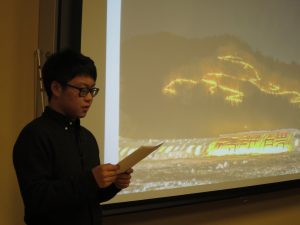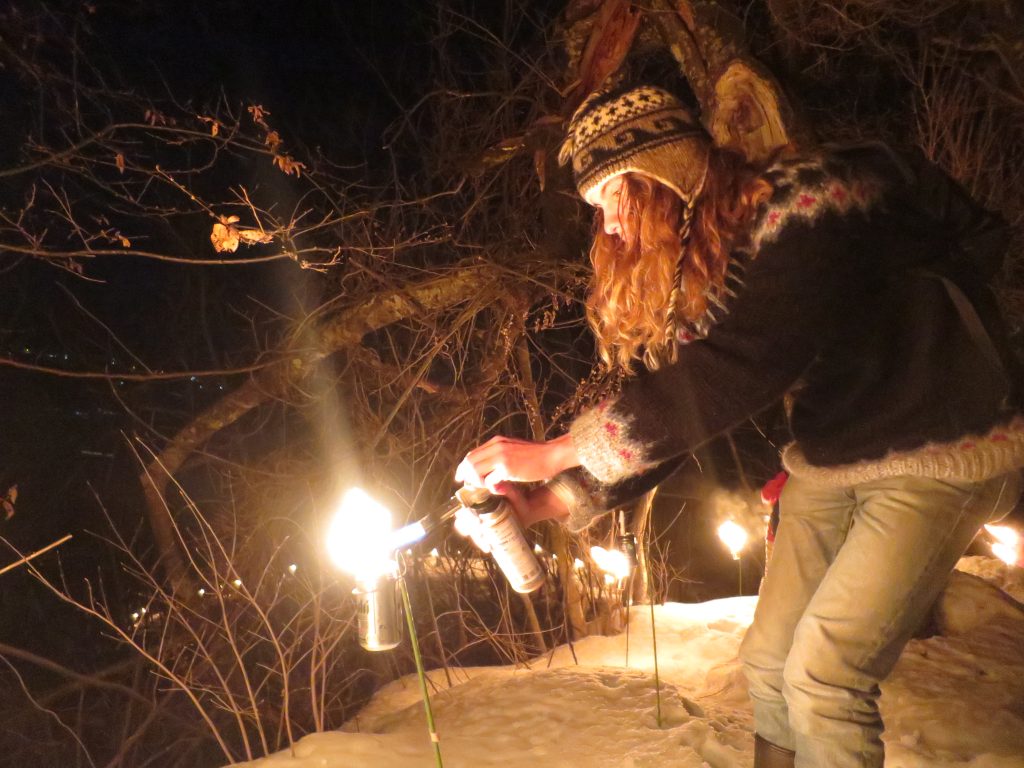Information
Winter Flames Highlight AIU International Students’ Local Community Interaction

After the festival, the international students gave a presentation on their experience- entirely in Japanese- with several of their weekend host families in attendance. The slide in the background shows the kirin burning on the mountain.
The Shiraiwa Joshi Tokasai (loosely translated, the “Fire Festival of Shiraiwa Castle Ruins”), began in 2002 as rural revitalization project in the Shiraiwa region of Senboku City, Akita. Since 2012, AIU international students have joined the local residents and schoolchildren in preparing the festival’s main attractions, hundreds of snow lanterns and an enormous flaming kirin burning on the side of Mt. Tateyama. The kirinis a sacred beast from Chinese mythology, most commonly represented with the head of a dragon, the body of a deer, the hooves of a horse, the tail of a cow, and generally with a single horn.
Before and after the festival day, the AIU students, on a special intensive program from AIU partner the Australian National University, stayed with local host families. Although it was only for two nights, they formed close bonds. When the students gave a presentation on their experience on the AIU campus in the middle of the following week, several of the families made the hour-plus drive from Shiraiwa to AIU to attend.
AIU international students arrived early in the morning of the festival and split up to assist the local organizers with the preparations. One group hiked up the snow-covered mountain to a shrine at the summit for a brief ceremony before staking torches made from recycled cans in the pattern of the kirin on the descent.
At the mountain’s foot, on the grounds of the castle ruins, the remaining students and villagers set up tents and built approximately 200 snow lanterns. The AIU students admitted in their presentation that their snow lanterns looked a little off, but the villagers encouraged them, saying that those lanterns had character.
Other students lined the roads to the festival grounds with candles enclosed in cut plastic bottles, to protect them from the wind, or filled balloons for the afternoon portion of the festival.

Once the preparations were complete, AIU students and local elementary school students went sledding together.
Later in the afternoon, children from the elementary school arrived and engaged the AIU students in a snowball fight and defeated them soundly, though that did not dampen their spirits. They danced and sledded together and, when it was time for the main festival to begin in the evening, the elementary school students, international students, and local organizers lit the kirin torches together, beginning from the top of the mountain and working downward in unison. When they reached the base, they could see the results of their work blazing on the mountainside and enjoy a fireworks display, as well. The evening concluded with hiburi kamakura, a sacred Lunar New Year tradition of swinging a meter-long burning-tipped rope around oneself to ensure good health and harvest for the coming year.
For most festival attendees, that was where the evening ended. But for the festival staff, including both the local community and AIU international students, there was an after-party to celebrate the successful event. Sharing a dinner, drinks, and an evening of camaraderie with the local villagers was, for the AIU international students, the most important part of the experience.
“The best part was that it wasn’t just a festival, but we had the sense of working together with the local community to accomplish something significant for the town,” one student concluded during the event presentation. “We came to understand the kindness and community of rural Japan.”
“I never really liked festivals before,” another added, to shocked gasps from the room. “But this changed my mind. It was truly a once-in-a-lifetime experience.”
Any international student who comes to Japan will surely have the opportunity to enjoy a festival or ten, some even have the chance to play a ceremonial or performing role. Very few get to be part of the festival organization and go behind the scenes alongside the local community to understand the organization and execution of the event. However, over the first weekend of February, a group of AIU international students got to do just that.

After the festival, the international students gave a presentation on their experience- entirely in Japanese- with several of their weekend host families in attendance. The slide in the background shows the kirin burning on the mountain.
Before and after the festival day, the AIU students, on a special intensive program from AIU partner the Australian National University, stayed with local host families. Although it was only for two nights, they formed close bonds. When the students gave a presentation on their experience on the AIU campus in the middle of the following week, several of the families made the hour-plus drive from Shiraiwa to AIU to attend.
AIU international students arrived early in the morning of the festival and split up to assist the local organizers with the preparations. One group hiked up the snow-covered mountain to a shrine at the summit for a brief ceremony before staking torches made from recycled cans in the pattern of the kirin on the descent.
At the mountain’s foot, on the grounds of the castle ruins, the remaining students and villagers set up tents and built approximately 200 snow lanterns. The AIU students admitted in their presentation that their snow lanterns looked a little off, but the villagers encouraged them, saying that those lanterns had character.Other students lined the roads to the festival grounds with candles enclosed in cut plastic bottles, to protect them from the wind, or filled balloons for the afternoon portion of the festival.

Once the preparations were complete, AIU students and local elementary school students went sledding together.
For most festival attendees, that was where the evening ended. But for the festival staff, including both the local community and AIU international students, there was an after-party to celebrate the successful event. Sharing a dinner, drinks, and an evening of camaraderie with the local villagers was, for the AIU international students, the most important part of the experience.
“The best part was that it wasn’t just a festival, but we had the sense of working together with the local community to accomplish something significant for the town,” one student concluded during the event presentation. “We came to understand the kindness and community of rural Japan.”
“I never really liked festivals before,” another added, to shocked gasps from the room. “But this changed my mind. It was truly a once-in-a-lifetime experience.”


